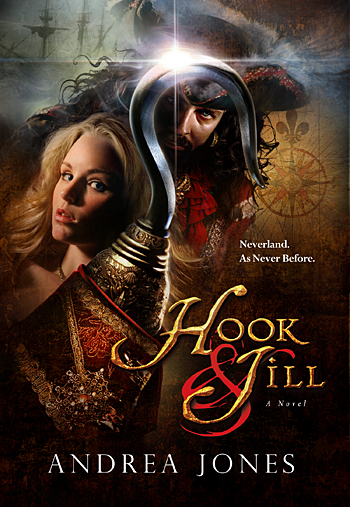Q&A with Andrea Jones, author of Hook & Jill
 by Carol Corbett
by Carol Corbett
June 30, 2009
What inspired you to write this twist on the classic “Peter Pan?”
As I watched the incomparable Jason Isaacs portray Captain Hook on film, I was drawn into his darkness. I conceived how the story should have evolved, if it followed his character’s lead instead of J.M. Barrie’s plot. The adventure began for me when Captain Hook arrived—very real—to talk with me in a dream, and the rest is…“his-story.”
What do you enjoy about being a first-time author?
Living with my characters. I’m so involved with them, I can’t stop intuiting their story. So until their adventures are complete, I’ll be writing happily ever after in the Neverland. I love discussing my books with readers, in any forum; I enjoy speaking at conferences, and staging readings. I’m a performance artist at heart.
There are some major psychological aspects here, can you elaborate on them?
Wendy is the storyteller, and all her characters are outward aspects of her own personality. Peter Pan represents her shining, heroic side; Captain Hook acts out her shadow’s schemes. Wendy must come to terms with the fact that she herself projected both the brightness of Peter and the blackness of Hook.
Hook & Jill is filled with symbolism. What are the key symbolic elements?
To name only a few, Time is a god, Tinker Bell is the true believer, and snapping at our heels slinks the fundamentalist Crocodile, hoarding the god in its belly, intolerant of anyone or anything unrestricted by law, in other words—Hook.
What do you mean by “the dark side of innocence”?
Barrie clearly created Hook and Peter to be two sides of the same coin. Both are ruthless, egotistical, and intelligent. The irony is that one is really no better than the other—but one is a grown-up, and therefore “responsible” for his behavior. The other is excused due to “youth.” But I have learned through painful experience that innocence can do harm. In Hook & Jill, I expose it.
What other words of wisdom do you express in the Captain’s philosophy?
Hook tells Wendy when she admits her guilt, “Shame cannot satisfy me, nor tutor you. Experience will do that.” We learn by our mistakes. Time spent indulging in shame is wasted; take the lesson and move on.
How do you see the public reacting to your unconventional ending?
I hope to hear outrage, and I hope to hear appreciation. A spectrum of reaction will mean my audience is thinking, and learning to think is the “moral of the story.” Along with the hedonism of Hook & Jill, I have my own morality, and knowledge is the most important value I hold. Education is the only way to salvage what we’ve done with our world.
How long did it take you to put this concept to paper?
I was truly inspired, even obsessed, for 6 months. I finished the very day in 2004 that I learned the year marked the 100th anniversary of “Peter Pan.” The characters led me where they had to go. I sometimes finished writing a neatly twisting scene and said, “I wish I’d thought of that!”
Do you feel Hook & Jill is bound for the stage? Why/when?
Absolutely. Although Peter Pan began his life as “just a story,” his tale was crafted by J.M. Barrie for the stage. The play evolved into a Broadway musical that audiences still clamor to see. And my own dramatic training makes Hook & Jill a very performable story. As for when, Time is a trickster in the Neverland, but I’m ready.
Any advice for aspiring writers?
Persistence, and editing. Seek out qualified writing partners to critique your work and give you the honest truth. I owe much to my patient and talented partners. Keep learning, keep the text evolving, and if you believe in your work, don’t let anyone tell you to give up on it. As Hook says, literally as well as figuratively, “Deny your desire and you end your story.”
